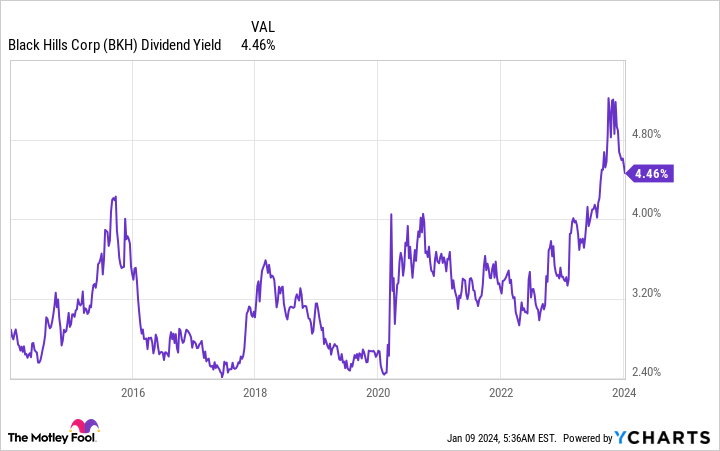Black Hills Corporation (BKH -0.83%) has one big claim to fame, it is a Dividend King with over 50 years of annual dividend increases behind it. That said, every business, even ones as reliable as Black Hills, go through good periods and bad ones. In 2023, the electric and natural gas utility was focused on battening down the hatches. That should change in 2024.
Black Hills is small, but mighty
When it comes to utility companies, most investors will probably think of industry giants such as NextEra Energy (NEE 0.53%). Given its $125 billion-plus market cap, that makes complete sense. But Black Hills Corporation, with its relatively tiny $2.8 billion market cap, trounces NextEra Energy on one key streak, given that it has increased its dividend annually for two decades more than NextEra Energy has. You don’t become a Dividend King by accident.
BKH Dividend Yield data by YCharts
That said, Black Hills stock has not been a favorite among investors. It’s down more than 20% over the past 12 months, and the dividend yield, at 4.4%, is up near 10-year highs. What’s been going on?
The first part of the story isn’t specific to Black Hills. The entire utility sector has been dealing with the impact of rising interest rates, which make alternative income investments like a certificate of deposit (CD) more attractive. Conservative investors unwilling to take on the risk of an equity investment can get yields up to 5% from ultra-low-risk CDs, pulling cash away from traditional income stocks like utilities.
More specific to Black Hills, however, rising rates increased the utility’s debt costs. In response, management shifted gears and focused on debt reduction in 2023. It was the right move.
Black Hills had to rob Peter to pay Paul
The problem is that money doesn’t come out of nowhere, so Black Hills had to cut back somewhere else to come up with the cash it used for debt reduction. That somewhere was its capital spending budget. This is a vital item for regulated utilities, because such spending is what allows them to convince regulators to approve rate increases. As such, capital spending is very important to monitor in the utility space.
In 2023 Black Hills capital spending dipped to around $600 million, as planned, creating an extra headwind for the stock. But as the company enters 2024, it expects to ramp back up on the capital investment front. This year, spending should be closer to $800 million, as Black Hills tries to make up for lost ground. In 2025 and beyond, spending will fall back to an around $700 million or so run rate. In other words, Black Hills will try to do the spending of two years in one in 2024.
There’s good news there, given that the spending from 2023 simply got delayed. So lost time, perhaps, but its plans didn’t completely unravel. That said, in 2024 there’s going to be a lot more work to get done, which increases execution risk for what is a relatively small company. Investors should probably keep a close eye on the company’s progress, even though the broader spending plan should be viewed through a positive lens.
Conservative income investors should look at Black Hills
If you’re trying to live off the dividends your portfolio generates, Black Hills should be on your radar. It’s a relative unknown in the utility sector and 2023 wasn’t the best year for the company. However, given the consistency with which it has returned value to investors through dividends over time and the capital spending plans it has for 2024, there may not be a lot of time left to buy it while it has a historically high yield.




